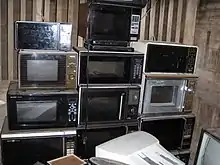Microwave oven
A microwave oven (commonly called a microwave) is a machine that cooks food using microwaves, a type of radio wave. The idea was invented when a scientist who was experimenting with radio waves saw his chocolate bar, which was in his pocket, had melted. He then knew that radio waves could cook food and invented the microwave oven.

History

In 1945, the heating effect of a high-power microwave beam was accidentally discovered by Percy Spencer, an American self-taught engineer from Howland, Maine. Hired by Raytheon at the time, he noticed that microwaves from an active radar set he was working on started to melt a chocolate bar he had in his pocket. First, Spencer deliberately cooked popcorn with a microwave oven. And the second time, he cooked an egg, which exploded in the face of one of the experimenters.[1][2]
To prove his finding, Spencer created a high density electromagnetic field by feeding microwave power from a magnetron into a metal box from which it had no way to escape. When food was placed in the box with the microwave energy, the temperature of the food rose rapidly. On 8 October 1945, Raytheon filed a United States patent application for Spencer's microwave cooking process, and an oven that heated food using microwave energy from a magnetron was soon placed in a Boston restaurant for testing.[3]
How it works

The microwave oven uses a magnetron, which is a type of vacuum tube. This is similar to a radio transmitter. It makes very short radio waves which go into the food to a depth of about 2.5cm (one inch). This makes water molecules twist about 2.5 billion times a second. This heats up the molecules around it. As they heat up the heat goes to the inside of the food. This process is called conduction. This also happens in a normal oven, but microwave energy goes deeper so that the food cooks much faster. In an ordinary oven the energy stays mostly near the surface, so it takes more time.[4]
Apart from this, the oven has a wave guide, turntable, and a timer switch. When we place the food inside the chamber and turn the timer switch on, it sends a command to the magnetron to send microwaves, as well as to the turn table to start turning. The microwaves of microwave ovens can heat foods containing polar molecules, such as water, as polar molecules are prone to the vibration effect caused by the microwaves. To heat the food evenly the microwave's turntable spins the food around.
Metals tend to spark in microwaves, rather than heating. The reason why is that metals like to give away electrons, so when the microwaves "push" at their magnet-like electrons, instead of turning, they just give the electrons away. A bunch of electrons running off of metal is called electricity, and we see it in the form of sparks.
Related pages
References
- Gallawa, John Carlton (1998). "The History of the Microwave Oven". Archived from the original on 2013-05-31.
- Radar — Father of the Microwave Oven at YouTube
- US patent 2495429, Spencer, Percy L., "Method of treating foodstuffs", issued 1950-January-24
- "Teaching the world to ping", The Independent, Thursday 12 May 2011; Viewspaper p.16